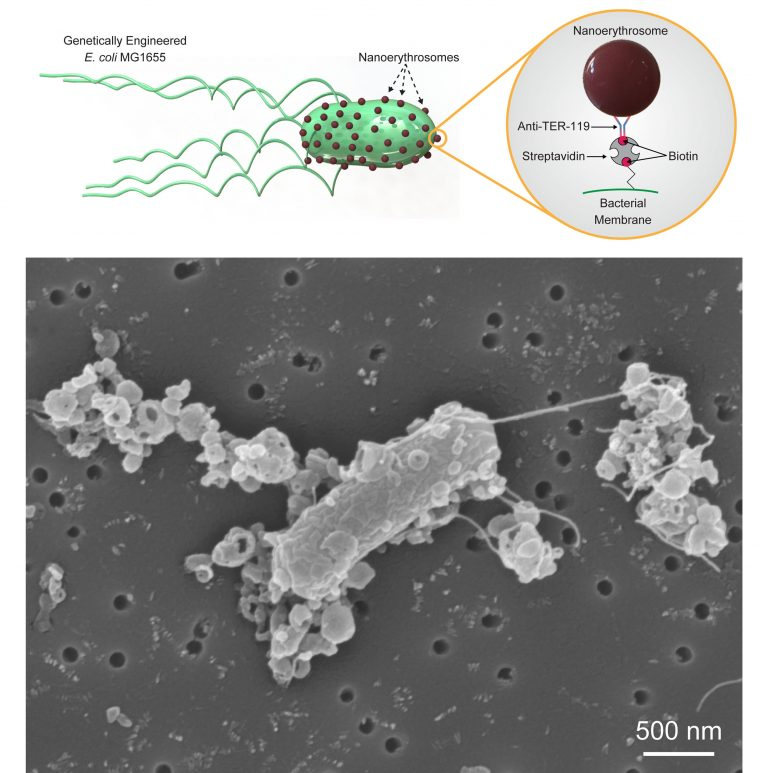Apr 8 2020
Tiny, microscale-biohybrid robots are capable of swimming through the body and delivering drugs to tumors. They can also perform other cargo-carrying functions.
 Illustration (top) and scanning electron microscopy image (bottom) of biohybrid bacterial microswimmers, which were fabricated by combining genetically engineered E. coli MG1655 and nanoerythrosomes made from red blood cells. A biotin-streptavidin interaction was used to attach nanoerythrosomes to the bacterial membrane. Image Credit: Image courtesy of the authors.
Illustration (top) and scanning electron microscopy image (bottom) of biohybrid bacterial microswimmers, which were fabricated by combining genetically engineered E. coli MG1655 and nanoerythrosomes made from red blood cells. A biotin-streptavidin interaction was used to attach nanoerythrosomes to the bacterial membrane. Image Credit: Image courtesy of the authors.
Bacteria are known to have natural environmental sensing tendencies. This means they can find their way toward specific chemicals or can be remotely controlled through sound or magnetic signals.
To be more effective, these small biological robots should contain materials that can pass the barriers via the body’s immune response. These robots should also have the ability to swim rapidly via viscous settings and enter the tissue cells to supply cargo.
In a study that was recently reported in AIP Publishing’s APL Bioengineering journal, scientists developed biohybrid bacterial microswimmers by integrating a genetically designed Escherichia coli (E. coli) MG1655 substrain as well as nanoerythrosomes, which are tiny structures created from red blood cells.
Nanoerythrosomes are essentially nanovesicles that are obtained from red blood cells by clearing the cells, retaining the membranes, and filtering them down to nanoscale size. Such small red blood cell carriers bind to the bacterial membrane through the strong non-covalent biological bond present between streptavidin and biotin.
This process maintains two essential red blood cell membrane proteins—TER119 required to bind the nanoerythrosomes, and CD47 to avoid macrophage uptake.
The E. coli MG 1655 acts as a bioactuator and carries out the mechanical work of quickly pushing through the body as a molecular engine utilizing flagellar rotation. The bacteria’s swimming abilities were evaluated using a customized two-dimensional (2D) object-tracking algorithm as well as 20 videos captured as raw data to record their performance.
Biohybrid microswimmers with bacteria carrying the red blood cell nanoerythrosomes performed at 40% faster speeds when compared to other E. coli-powered microparticles-based biohybrid microswimmers.
The study showed a decreased immune response because of the nanoscale size of the nanoerythrosomes and also due to the changes made to the coverage density of nanoerythrosomes on the membrane of the bacteria.
Such biohybrid swimmers can potentially deliver drugs more rapidly because of their swimming speed and composition, and they also face less immune response.
The scientists have planned to continue their study to further adjust the immune clearance ability of the microrobots and analyze how they might enter into the cells and discharge their cargo in the tumor microenvironment.
This work is an important stepping stone in our overarching goal of developing and deploying biohybrid microrobots for therapeutic cargo delivery. If you decrease the size of red blood cells to nanoscale and functionalize the body of the bacteria, you could obtain additional superior properties that will be crucial in the translation of the medical microrobotics to clinics.
Metin Sitti, Study Author and Director, Max Planck Institute for Intelligent Systems